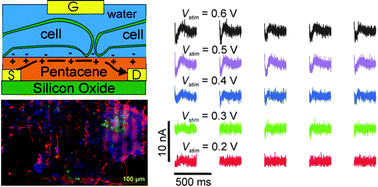Electronic transducers of neuronal cellular activity are important devices in neuroscience and neurology. Organic field-effect transistors (OFETs) offer tailored surface chemistry, mechanical flexibility, and high sensitivity to electrostatic potential changes at device interfaces. These properties make them attractive for interfacing electronics with neural cells and performing extracellular recordings and stimulation of neuronal network activity. In this work we operate pentacene ultra-thin film (9 nm thick) transistors with a liquid gate both as transducers and electrical stimulators of neuronal network activity. These devices are highly sensitive to small potential changes in cell medium and exhibit sufficient stability under standard cell culture conditions for nine days. We show that murine neural stem cells can be adhered on top of functional devices without the need for an additional layer of cell-adhesive molecules, and then differentiated into neuronal networks. OFET response is monitored during the different phases of the neuronal differentiation process up to nine days. Only when stem cells are differentiated into neurons, it is possible to measure electrical signals in the OFET current following the stimulation. Due to the large sensing area of our device, which accommodates from hundreds to thousands of interconnected neurons, the OFET electrical signals arise from the collective electrophysiological response of the neuronal population. The maximum extracellular potential change in the cleft region adjacent to the transistor surface amounts to 350 μV. This demonstrates that pentacene ultra-thin film OFETs enable good cellular adhesion and efficient coupling of the ionic currents at the biological–organic semiconductor interface with the OFET current.

You have access to this article
 Please wait while we load your content...
Something went wrong. Try again?
Please wait while we load your content...
Something went wrong. Try again?


 Please wait while we load your content...
Please wait while we load your content...